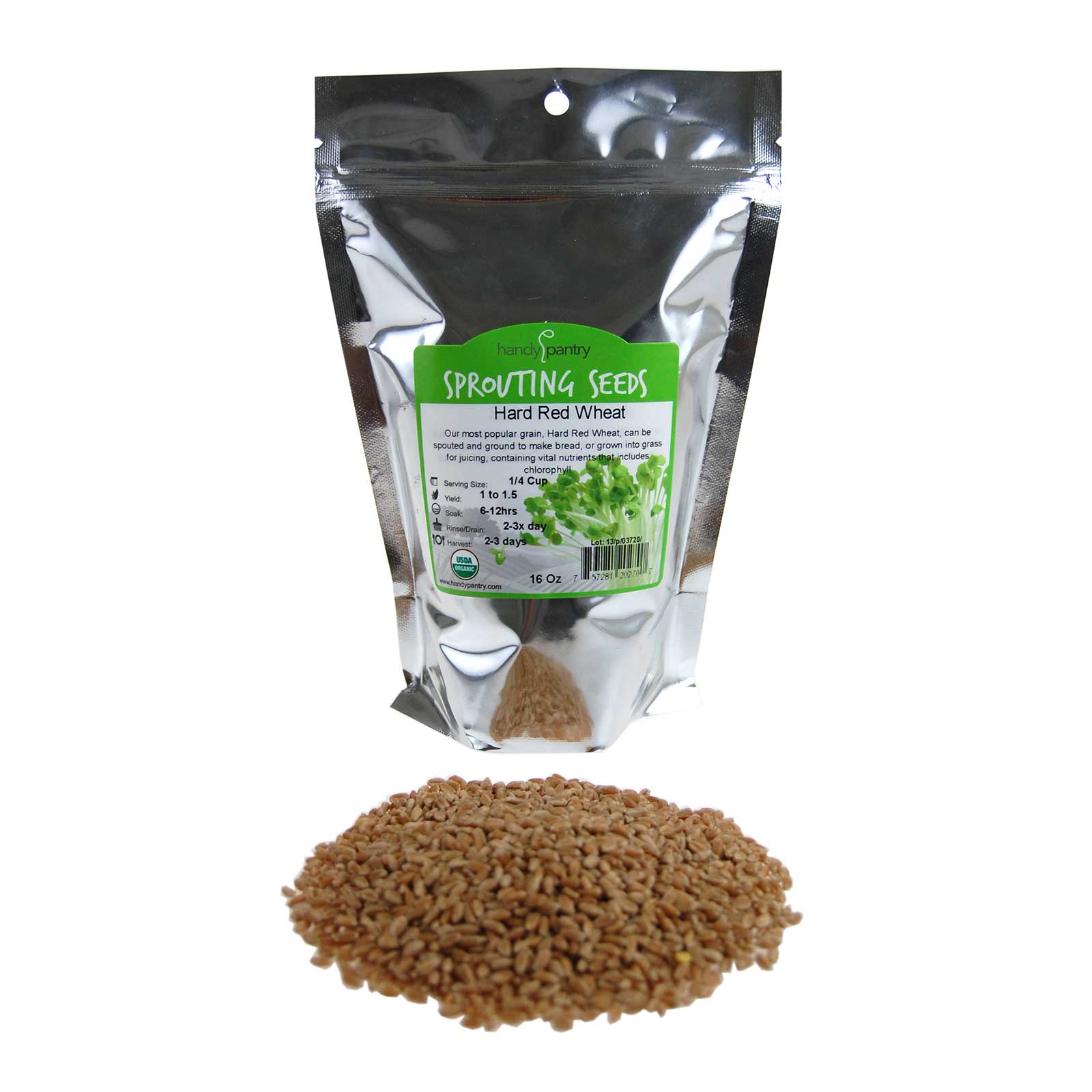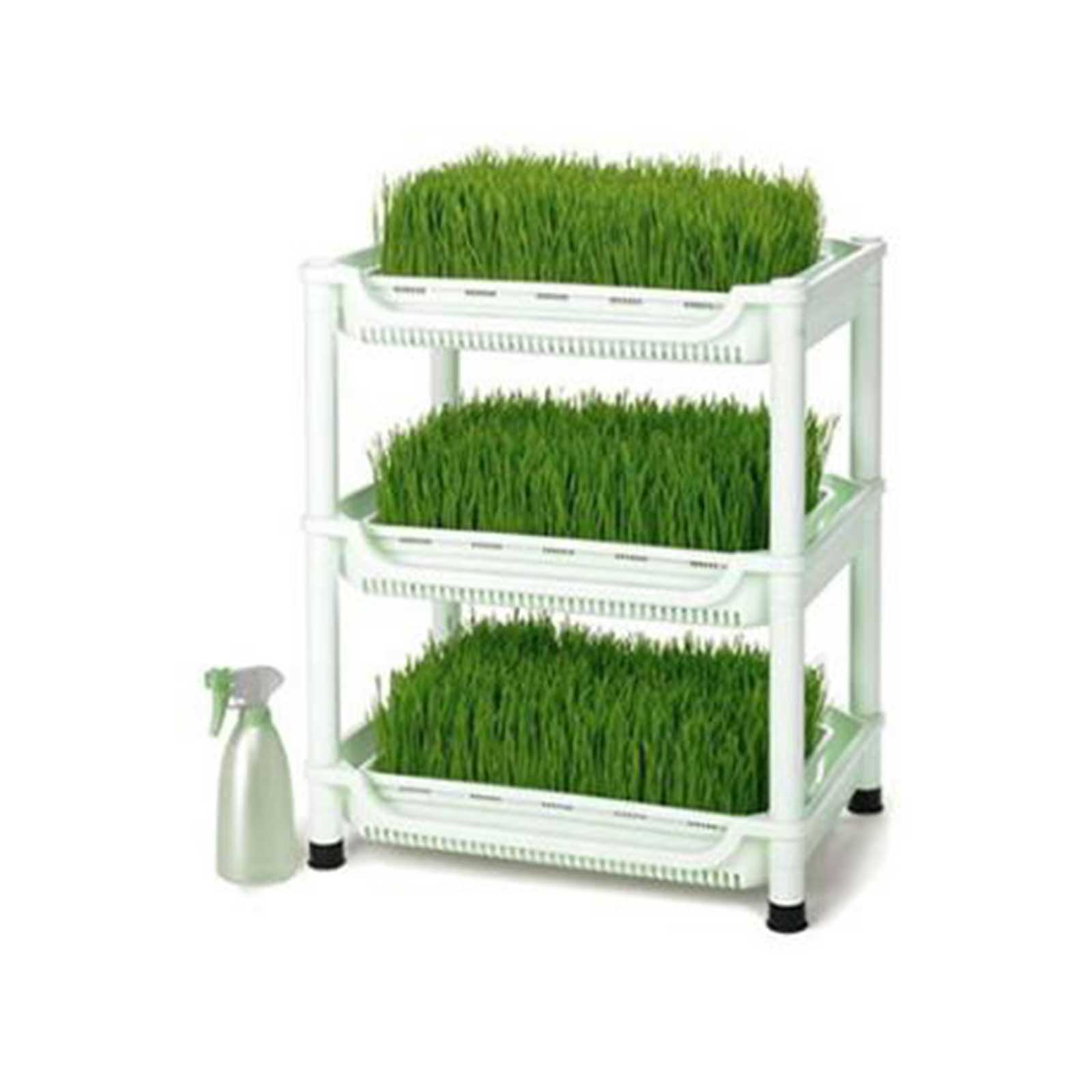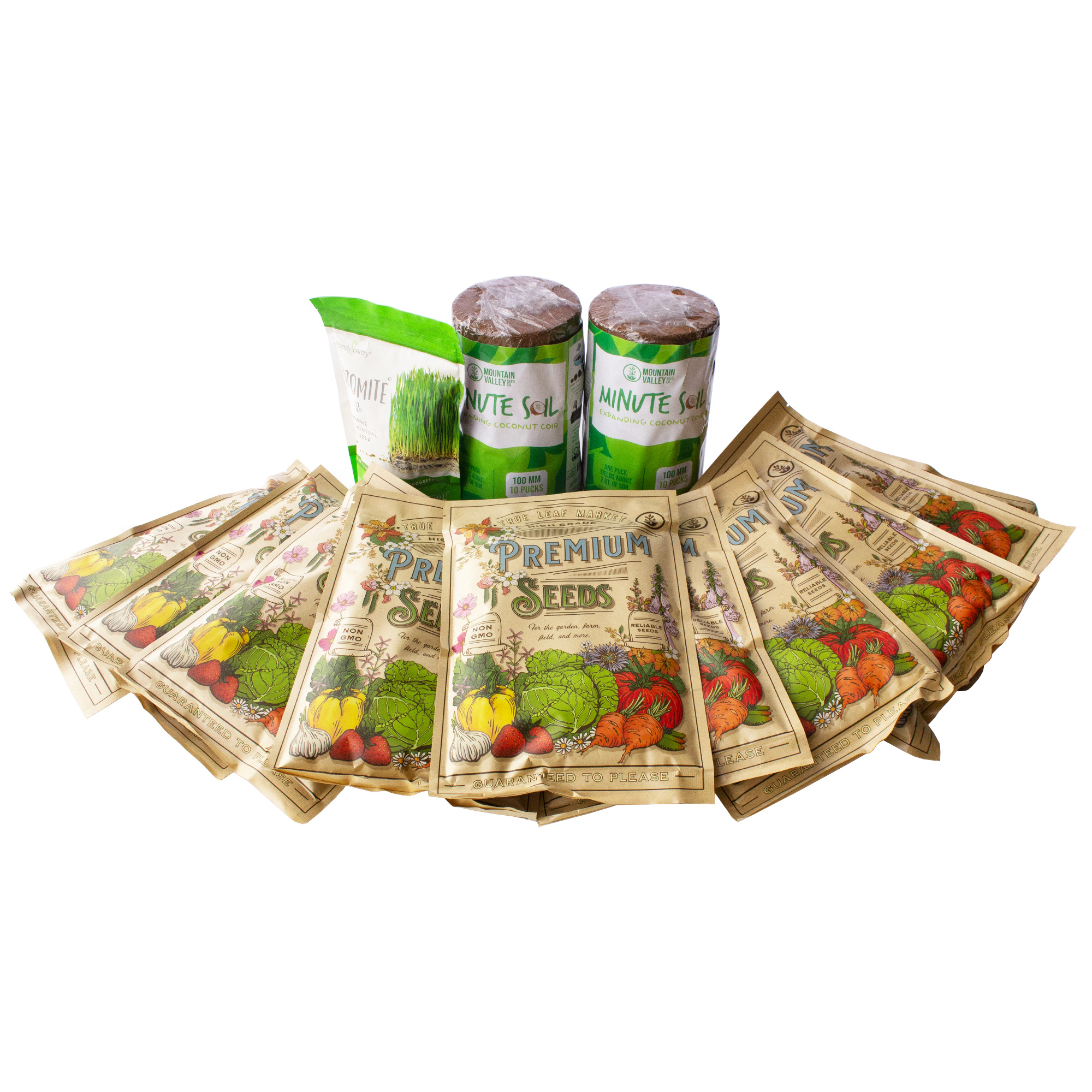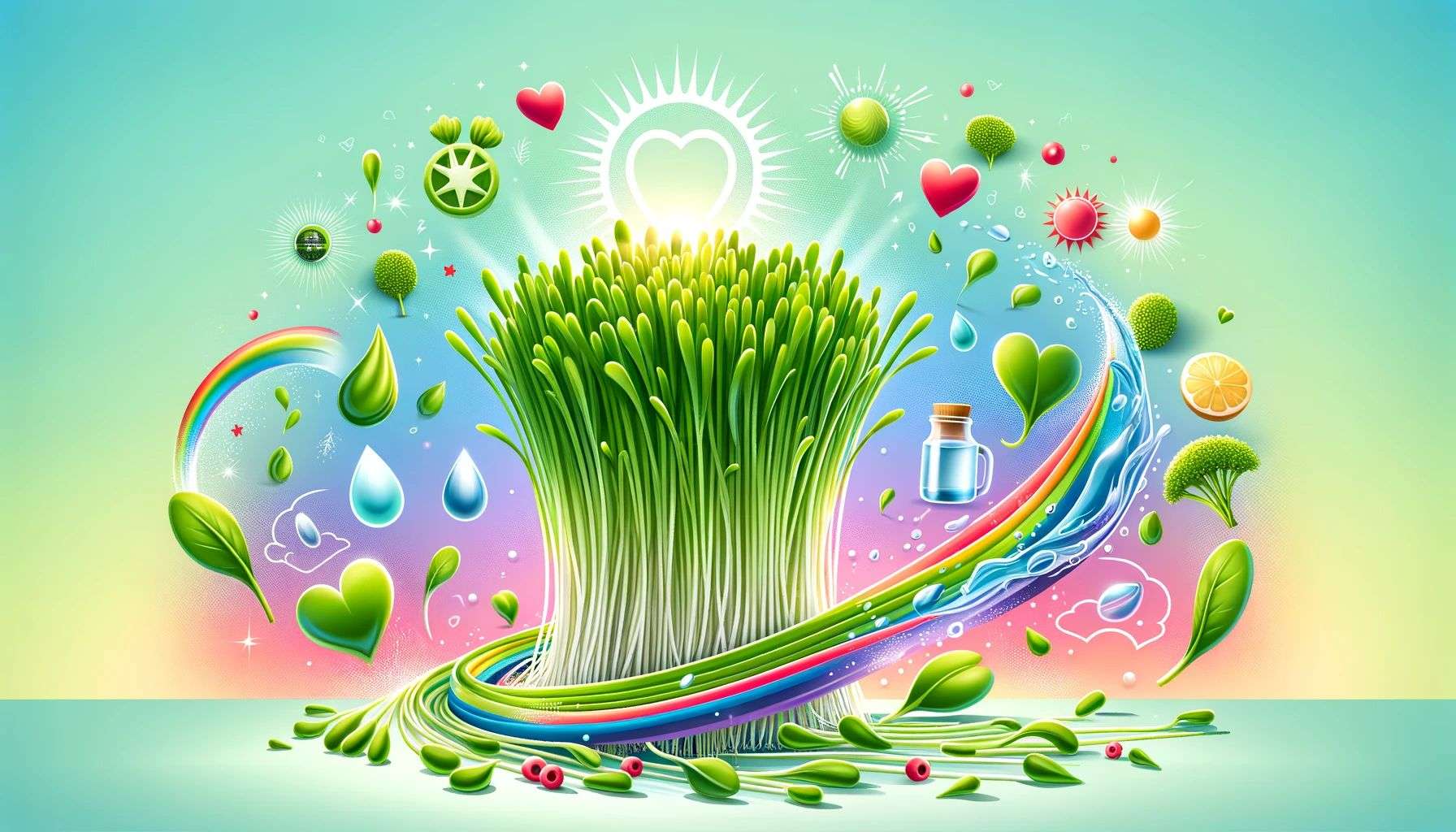Wheatgrass Microgreens: Discover the Health Benefits of this Indoor Gardening Marvel
Some of our posts on Microgreensguru.com contain affiliate links. If you click on an affiliate link and make a purchase, we may receive a commission. Clicking on an affiliate link that earns a commission does NOT result in additional charges or costs you extra. Earnings from affiliate links help keep this website running. See our full affiliate disclosure here.
Wheatgrass microgreens have surged in popularity over the last decade as health enthusiasts discover their incredible nutritional benefits. These tiny young grass shoots contain a powerhouse of vitamins, minerals, antioxidants, and chlorophyll concentrated into a single miniature plant.
Home gardeners are turning to wheatgrass microgreens as an easy way to add nutritious greens to their diet. Microgreens can be grown easily on a windowsill or under grow lights with minimal supplies. In just 7-10 days they are ready to harvest for smoothies, juices, and gourmet dishes.
Keep reading to learn everything you need to know about growing your own trays of wheatgrass microgreens at home.
Key Takeaways on Wheatgrass Microgreens
- Wheatgrass microgreens contain very high concentrations of chlorophyll, vitamins, minerals, and enzymes compared to mature wheatgrass and vegetables.
- The diversity of nutrients and antioxidants in wheatgrass offers incredible health benefits like detoxification, reducing inflammation, and supporting immunity, and cardiovascular health.
- Microgreens harness a plant’s early rapid growth potential, concentrating nutrients from the seed. This makes them extra nutritious.
- Wheatgrass microgreens are grown as baby greens, and harvested after just 1-3 weeks once the first true leaves emerge. This captures peak nutrition before it declines.
- Wheatgrass is easy to grow at home in trays with just a sunny window or LED grow lights. Harvest your greens for juicing, smoothies, and gourmet dishes.
- Follow simple growing steps like pre-sprouting seeds and keeping sprouts humid and dark initially for faster, healthier growth. Then expose it to light.
- Control moisture carefully when growing wheatgrass to prevent mold or seedling issues. Bottom-watering trays help prevent problems.
- Maintain clean equipment and growing conditions to avoid potential mold, fungi, or pests when cultivating indoor greens.
- Try adding just 1-2 ounces of wheatgrass microgreens to your diet daily to receive a major infusion of nutrients from these super-concentrated greens.
Growing wheatgrass microgreens unlocks powerful health benefits from a single small plant. With just a sunny spot and basic supplies, you can easily grow trays of these superfood greens at home.

What Are Wheatgrass Microgreens?
Wheatgrass microgreens are the young seedlings of wheatgrass grown as baby greens. They are harvested soon after the first leaves emerge, just 1-3 inches tall. This is typically 7-14 days after germination depending on growing conditions.
The wheatgrass varieties used to grow microgreens are the same types used to grow wheat crops. Hard red and hard white winter wheat varieties are most commonly used. Durum and spring wheat can also produce good microgreens.
Unlike mature wheatgrass grown for juicing, which is cut once it reaches 6-8 inches, wheatgrass microgreens are snipped off while the shoots are still small. This captures them at their peak nutrition. Mature wheatgrass contains nutrients like chlorophyll, vitamins and minerals. But microgreens contain higher concentrations plus a diversity of antioxidants.
Why Are Microgreens More Nutritious Than Mature Plants?
Microgreens harness the immense growth potential contained within a seed. When a seed germinates, it contains a packet of concentrated nutrients designed to feed the plant until it can manufacture its own food from sunlight.
These pre-packaged nutrients fuel rapid growth, which shows up clearly when you compare the tiny seed to the size of microgreens in just 1-2 weeks.
This growth demands nutrients, which microgreens draw from their endosperm – the stored food within a seed. Harvesting microgreens allows us to eat these nutrients before the plant sends them into roots and leaves.
As plants mature, the concentrations of vitamins and antioxidants decrease. So microgreens contain much higher nutrient levels compared to mature plants.
Let’s look closer at why wheatgrass microgreens offer a real nutritional punch.

The Nutritional Benefits of Wheatgrass Microgreens
Wheatgrass microgreens deliver a concentrated dose of:
- Vitamins
- Minerals
- Enzymes
- Chlorophyll
- Antioxidants
This makes them a true superfood that packs a lot of nutrition into a tiny plant.
Vitamins
Wheatgrass microgreens contain high levels of:
- Vitamin C
- Vitamin E
- Vitamin K
They also provide:
- Vitamin A
- B complex vitamins like thiamin, riboflavin and niacin
Vitamins C, E, and A are powerful antioxidants that destroy free radicals and reduce inflammation. Vitamin K supports bone and heart health. And B vitamins are essential for converting food into energy.
Minerals
Key minerals found in wheatgrass microgreens include:
- Iron
- Zinc
- Selenium
- Magnesium
- Calcium
Iron carries oxygen throughout the body. Zinc boosts the immune system. Selenium acts as an antioxidant. Magnesium helps build bones and DNA synthesis. And, calcium is crucial for bone health, muscle, and nerve function.
Chlorophyll
One of the most valuable components of wheatgrass is chlorophyll, the green pigment that allows plants to absorb energy from sunlight.
Wheatgrass contains very high levels of chlorophyll. It is strikingly similar in structure to hemoglobin, the compound that carries oxygen in our red blood cells.
Some research shows wheatgrass chlorophyll can boost red blood cell health. It also has antibacterial effects and may help detoxify the liver.
Enzymes
Enzymes are proteins that speed up chemical reactions like digesting nutrients. Wheatgrass contains beneficial enzymes like:
- Amylase
- Protease
- Cytochrome
- Lipase
These enzymes aid in breaking down fats, proteins and carbohydrates. Some research suggests wheatgrass enzymes can improve digestion and nutrient absorption.
Antioxidants
In addition to antioxidant vitamins like C and E, wheatgrass contains antioxidant compounds like flavonoids and phenolic acids.
Antioxidants neutralize free radicals that can damage cells and cause illness. The diversity of antioxidants in wheatgrass microgreens makes them extremely beneficial.
Research shows microgreens have up to 4-40 times more antioxidants compared to mature plants. Their antioxidant activity greatly exceeds common vegetables.
So in summary, wheatgrass microgreens offer a nutrient density unmatched by mature wheatgrass and most other vegetables. The combination of vitamins, minerals, enzymes, chlorophyll, and antioxidants makes them a true superfood.
Now let’s look at the amazing health benefits you can gain by eating wheatgrass microgreens.
Table 1: Complete Nutritional Profile of Wheatgrass Microgreens
| Nutrient | Amount | % Daily Value* | Benefits |
| Vitamin A | 2815 IU | 56% | Antioxidant, supports eyesight |
| Vitamin C | 51.5 mg | 86% | Antioxidant, boosts immunity |
| Vitamin E | 1.2 mg | 6% | Antioxidant, heart health |
| Vitamin K | 145 mcg | 181% | Bone & blood health |
| Thiamin | 0.08 mg | 5% | Converts food into energy |
| Riboflavin | 0.11 mg | 9% | Cell growth & function |
| Niacin | 0.5 mg | 3% | Digestion, nerve function |
| Vitamin B6 | 0.1 mg | 5% | Protein metabolism |
| Folate | 12 mcg | 3% | Cell division & DNA |
| Pantothenic Acid | 0.25 mg | 3% | Metabolism of fats & proteins |
| Calcium | 24 mg | 2% | Bone & muscle health |
| Iron | 0.7 mg | 4% | Oxygen-carrying red blood cells |
| Magnesium | 16 mg | 4% | Nerve & muscle function |
| Phosphorus | 36 mg | 4% | Bone formation, cell repair |
| Potassium | 72 mg | 2% | Heart function, fluid balance |
| Zinc | 0.3 mg | 2% | Immune function, cell growth |
| Copper | 0.1 mg | 5% | Bone & nerve health |
| Manganese | 0.2 mg | 10% | Bone development & metabolism |
| Selenium | 0.4 mcg | 1% | Thyroid health, antioxidant |
*Based on a 2,000 calorie diet

The Health Benefits of Wheatgrass Microgreens
Here are some of the top scientifically-proven ways wheatgrass microgreens can improve your health:
1. Detoxification
The chlorophyll in wheatgrass microgreens helps cleanse the body of toxins. Chlorophyll binds to heavy metals and pollutants, stopping them from being reabsorbed. This allows toxins to be flushed out safely.
Chlorophyll also boosts liver function. Your liver is responsible for filtering toxins out of the blood. So improving liver health aids detoxification.
By reducing toxin levels and supporting liver function, wheatgrass microgreens offer a powerful cleansing effect.
2. More Energy
Wheatgrass microgreens are an excellent source of chlorophyll, iron, and B vitamins – all nutrients that fight fatigue and increase energy levels.
Chlorophyll harnesses the sun’s energy within plants. Some studies show it can boost energy and endurance in humans as well.
Iron carries oxygen throughout your body to supply your cells with energy. And B vitamins help convert food into usable fuel.
The high vitamin, mineral and chlorophyll content of wheatgrass makes it the perfect energy-boosting food.
3. Anti-Inflammatory Effects
Inflammation is at the root of most chronic diseases. Wheatgrass contains several compounds with potent anti-inflammatory effects.
Chlorophyll reduces inflammation to speed healing. The antioxidant vitamin C also tamps down inflammation.
Wheatgrass microgreens contain antioxidant phenolic acids and flavonoids that prevent inflammation. Researchers have found young wheatgrass shoots are especially high in inflammation-fighting antioxidants.
The anti-inflammatory activity of wheatgrass microgreens makes them beneficial for arthritis, joint pain, IBS, and other inflammatory conditions.
4. Supports Heart Health
Wheatgrass microgreens benefit your heart and circulatory system in multiple ways. The iron content helps increase red blood cells, which deliver oxygen throughout your body.
Vitamin K improves blood clotting. The antioxidant vitamin C protects heart cells from free radical damage. And wheatgrass may help lower cholesterol levels in your blood.
The nutrients and antioxidants in wheatgrass support cardiovascular function, making it a heart-healthy food.
5. Aids Digestion
If you suffer from frequent gas, abdominal discomfort, or digestive issues like IBS, wheatgrass microgreens may help provide relief.
Wheatgrass contains digestive enzymes that assist in breaking down fats, complex carbs, and proteins into smaller components for better absorption. This takes the strain off your digestive system.
The nutrients in wheatgrass also promote the growth of healthy gut bacteria. And, wheatgrass acts as a gentle laxative to relieve constipation.
With its high enzyme content and nutritional profile, wheatgrass is excellent for improving digestion.
Table 2: Health Benefits of Key Nutrients in Wheatgrass
| Nutrient | Benefits |
| Vitamin C | Powerful antioxidant, anti-inflammatory, immunity booster |
| Vitamin K | Blood clotting, bone health, reduces inflammation |
| Iron | Oxygenates blood, increases energy & endurance |
| Chlorophyll | Detoxification, antioxidant, wound healing |
| Enzymes | Improve digestion & nutrient absorption |
| Selenium | Boosts thyroid function, antioxidant, immunity |
| Magnesium | Relieves muscle cramps & tension, nerve conduction |
6. Fights Cell Damage
Free radicals are unstable molecules that damage cells, causing illness and speeding up aging. Wheatgrass contains at least a dozen antioxidants that neutralize free radicals.
Vitamin C, vitamin E, selenium, and chlorophyll act as antioxidants. Wheatgrass microgreens also contain antioxidant phenolic acids and flavonoids.
The diversity of antioxidants makes wheatgrass effective at combatting oxidative stress. And research shows microgreens have far higher antioxidant activity than mature plants.
7. Supports Immunity
Your immune system acts as your body’s defense against disease. Wheatgrass microgreens boost immunity in several ways.
First, they contain antioxidant vitamins A, C, and E which support healthy immune function. Selenium and zinc increase immune cell activity. Chlorophyll also enhances immune response.
The anti-inflammatory effects of wheatgrass prevent excessive inflammation triggered by an overactive immune system. This helps fight chronic inflammation.
With its variety of nutrients and antioxidants, wheatgrass strengthens your immune defenses.
8. Improves Metabolism
Wheatgrass microgreens help boost your metabolism to burn energy more efficiently. As nutrient-dense greens, they provide vitamins, minerals, and enzymes to optimize metabolic function.
The chlorophyll in wheatgrass increases oxygen supply to cells, allowing your body to produce energy more effectively. Thiamine (vitamin B1) also aids metabolism.
Eating nutrient-rich greens instead of processed carbs or sugars also helps balance blood sugar levels. This provides sustained energy and prevents spikes.
A faster metabolism means you’ll burn calories more efficiently, especially after consuming wheatgrass microgreens.
9. Fights Cancer
Some early studies suggest wheatgrass may help prevent cancer by neutralizing carcinogenic substances and preventing cellular mutation.
The chlorophyll in wheatgrass binds to environmental toxins associated with cancer like mold, arsenic, and DDT. This allows your body to eliminate these toxins before they can cause damage to DNA.
Wheatgrass also contains enzymes like glutathione peroxidase that help fight carcinogens. And its diversity of antioxidants prevents free radical damage that can trigger cancer growth.
More research is needed, but the detoxifying effects of wheatgrass show promise for cancer prevention.
10. Dental Care
Wheatgrass microgreens can also play a role in maintaining healthy teeth and gums. The chlorophyll, vitamin C, and other nutrients help reduce inflammation that damages gums.
Some studies indicate wheatgrass may help fight oral bacteria that cause tooth decay. Rinsing your mouth with wheatgrass juice could potentially help prevent cavities and gum disease.
Wheatgrass delivers a concentrated punch of vitamins, minerals, enzymes, and antioxidants that offer amazing health benefits well beyond basic nutrition. Harnessing these benefits is as simple as growing wheatgrass microgreens at home.
Now let’s discuss how to cultivate your own nutritious wheatgrass greens!

The Importance of the Blackout Period for WheatGrass Microgreens
One of the keys to getting hearty, healthy wheatgrass microgreens is giving them a period of darkness after planting. This “blackout” time allows the sprouts to focus energy on root growth before emerging into the light.
After planting pre-sprouted seeds in your tray, cover the tray with an upside-down second tray or other light-blocking cover. Drape a towel over the tray setup to help retain humidity.
Keep the sprouting wheatgrass in complete darkness for 3-5 days. During this time, they are establishing their root systems. Blocking light signals the shoots to send roots downward searching for moisture and nutrients.
This blackout period mimics the darkness underground before sprouts emerge from the soil. It results in a thicker, denser network of roots.
Robust roots allow the wheatgrass seedlings to better uptake moisture and nutrients once exposed to light. So the blackout jumpstarts growth, spurring the rapid production of chlorophyll and vitamins that make wheatgrass microgreens a superfood.
It may be tempting to sneak an early peek at your sprouts after a couple of days. But avoid exposing them to light until most have reached an inch in height. Even brief light can slow down root growth.
Patience during the 3-5 day blackout will pay off with vigorous, healthy wheatgrass microgreens once they enter the rapid vertical growth stage. Some gardeners even note larger yields from trays given adequate blackout time.
The simple step of blocking light is critical to growing great wheatgrass microgreens and harnessing their full nutritional potential. By providing a few days of darkness, your wheatgrass roots anchor firmly to support rapid nutrient-packed growth.

Growing Wheatgrass Microgreens Step-By-Step
While wheatgrass might seem exotic, it’s actually simple to grow at home. All you need are a few basic supplies and a flat spot near a window or under a light.
Follow these steps to grow your own wheatgrass microgreen trays:
Step 1. Choose Your Wheatgrass Seeds
You can use seeds from most wheat varieties to grow wheatgrass. But hard winter wheat types give the highest yields and fastest growth.
Look for organic, non-GMO seeds from winter wheat types like hard red or hard white wheat. Durum and spring wheat also work well.
Good seed sources will have a high germination rate above 90%, producing more microgreens per tray. Buy seeds specifically sold for wheatgrass rather than normal wheat grain.
Make sure your seeds are fresh, preferably from the current year’s harvest. Store extra seeds in an airtight container in the fridge or freezer.
Step 2. Pick a Growing Tray
Wheatgrass microgreens are typically grown in shallow trays about 2 inches deep. This prevents overwatering since they have small root systems.
Choose trays made from food-safe plastic or stainless steel. Opt for trays that are 10-20 inches wide for larger harvests.
Trays must have drainage holes in the bottom to prevent soggy soil and mold growth. Pick trays with 0.5 inch holes spaced a few inches apart.
You can also use growing trays made with mesh bottoms for excellent drainage. Drip trays catch excess water underneath.
Other containers like plastic clamshells or aluminum baking trays work too as long as they have drainage.
Step 3. Select a Soil Medium
Wheatgrass can be grown in standard potting soil or soilless mediums. Soilless mixes are cleaner and more sterile with lower mold risk.
Some good options are:
- Coconut coir – Made from ground coconut husks, retains moisture well.
- Coco peat – The dust left over after processing coconut coir.
- Sphagnum peat moss – Light, airy texture.
- Vermiculite – Holds moisture and aerates roots.
- Perlite – Increases drainage and aeration.
- Rockwool – Insulates roots and retains moisture.
- Hemp mats – Need frequent misting but produce clean microgreens.
Avoid mediums with synthetic fertilizers as they may burn young grass shoots. Nutrient additives aren’t necessary for short-term microgreen growth.
If using an inert medium like perlite, mix in some worm castings or kelp meal to provide nutrients. A sprinkle of compost is also beneficial.
Step 4. Soak Seeds
Soaking your seeds kickstarts the germination process, making them sprout faster once planted.
Place seeds in a jar and cover with 2-3 inches of water. Let soak for 8-12 hours at room temperature.
Drain the water and give the seeds a freshwater rinse. Drain again. Repeat rinsing 1-2 more times until seeds show the tiny root emerging.
Soaking softens the seed coat, allowing water to penetrate and reach the embryo inside. This activates enzymes to start cell division and growth.
Table 3: Daily Wheatgrass Microgreen Growing Schedule
| Day | Tasks |
| Day 1 | Soak seeds 8-12 hours |
| Day 2 | Drain, rinse & plant sprouted seeds |
| Day 3 | Mist plantings, keep covered |
| Day 4 | Mist plantings, keep covered |
| Day 5 | Uncover trays, move to light |
| Day 6 | Mist 1-2 times |
| Day 7 | Mist 1-2 times |
| Day 8 | Mist 1-2 times |
| Day 9 | Harvest microgreens! |
Step 5. Plant Presprouted Seeds
Fill your tray with premoistened growing medium, leaving at least 0.5 inch from the top. Smooth and lightly pack.
Pour rinsed sprouted seeds evenly over the tray. Spread seeds so there’s space between them but not huge bare patches.
Lightly mist the seeds to moisten. They should now stay moist from the water wicked up from below.
Seeds can be planted more densely than they’ll grow. Wheatgrass stems are thin so microgreens fill in gaps.
Step 6. Create Humid Darkness
Creating humidity and darkness mimics conditions under the soil before sprouts emerge. This spurs faster root growth.
Place an upside-down tray on top to block light. Cover with a towel to hold in moisture.
Let new seedlings sit 3-5 days until the grass reaches 1-2 inches tall. Checking them in light briefly is okay.
Step 7. Expose to Light
Once sprouts pass the 1-inch mark, remove the top tray and towel. Place the uncovered tray near a sunny window or under grow lights.
Wheatgrass needs as much light as possible for photosynthesis. Direct sun for part of the day is ideal.
If using grow lights, standard fluorescent or LED grow bulbs work well. Place lights very close to the trays, just 2-4 inches above the shoots.
Step 8. Continue Mist Watering
Wheatgrass microgreens have shallow roots and dry out quickly. Mist trays with water 1-2 times daily to maintain even moisture.
Spray water gently to avoid disturbing new sprouts. Check that the growing medium stays moist, not sopping wet.
Bottom-watering trays also work well. Place trays in a shallow tub of water for moisture to wick upwards into the soil.
Step 9. Harvest Microgreens
In 7-14 days total from seeding, wheatgrass microgreens will reach 1-3 inches tall. Now they are ready to harvest!
Use clean scissors or kitchen shears to cut microgreens just above the soil line. Aim for uniform height.
Harvesting in the morning ensures crispness before daytime wilting. Handle carefully to avoid bruising tender greens.
Rinse off microgreens and spin or pat dry with a towel. Store chilled in airtight containers to retain freshness.
Wheatgrass microgreens grow back for 1-2 more cuttings. But flavor and nutrition decline with subsequent harvests. Replant once growth seems weak.

Problems Growing Wheatgrass Microgreens
Wheatgrass is quite robust but can run into common microgreen problems if conditions aren’t right:
- Mold growth: Caused by excessive moisture and humidity. Improve airflow and mist instead of soaking trays.
- Leggy, falling over: Insufficient light, grow lights too far away. Move closer to the window or brighten the grow lights.
- Yellowing: Overwatering or very old seeds. Allow soil to partly dry out and use fresh seeds. Can also be caused by nutrient deficiencies.
- Weak germination: Seeds need warmer temperatures. Heat mats can raise soil temp 10+ degrees if the room is cold.
- White spots: Possible sign of grass mites. Remove plants immediately and thoroughly clean trays and tools to eliminate mites.
- Slime, mushiness: Bacterial or fungal infection. Toss trays and sanitize gear. Keep humidity in check.
Table 4: Troubleshooting Common Wheatgrass Microgreen Problems
| Problem | Potential Causes | Improve ventilation, and mist instead of soaking |
| Mold growth | Excess moisture, poor airflow | Use a heat mat, grow in a warmer area |
| Leggy, falling over | Insufficient lighting | Move closer to the window, adjust the grow lights |
| Yellowing | Overwatering, old seeds | Allow to partly dry, use fresh seeds |
| Weak germination | Low temperatures | Use a heat mat, grow in a warmer area |
| White spots | Possible grass mites | Remove plants, sanitize equipment |
| Slime, mushiness | Bacteria/fungus | Discard plants, sanitize equipment |
Following the growing guidelines carefully prevents most problems with mold and pests. But wheatgrass microgreens are quite forgiving if issues do arise.

Undoubtedly the best wheat we have ever used for growing wheatgrass. It is organic hard… [More]

The sproutman growing rack by Tribest will fit three trays of wheatgrass, barleygrass o… [More]

Convenient 10 pack refill kits for both soil based and hydroponic based wheatgrass grow… [More]

This plant growing rack will fit one tray of wheatgrass, barleygrass or microgreens at … [More]
Tips For Growing Great Wheatgrass Microgreens
Here are some handy tips and tricks for getting the healthiest, most productive wheatgrass trays:
- Presoak seeds 8-12 hours before planting. Sprouted seeds grow faster.
- Plant 4-6 oz wheatgrass seeds per standard 10×20″ tray. More seeds = higher yield.
- Add 1 teaspoon of kelp powder per 4oz seeds for a growth boost. Provides trace nutrients.
- Bottom-water trays until you see moisture beading on the surface. Less mold risk.
- Grow indoors or in a greenhouse to control temperature, humidity, and light. Outdoors can work too.
- Place seed trays 2-4 inches below LED grow lights. Fluorescent tubes even closer.
- Rotate trays daily if growing by a window for even sunlight exposure.
- Ventilate area well and space trays apart if you notice fungus gnats or mold.
- Rinse microgreens before juicing to remove any seed husks or debris. Gently pat dry.
- Wheatgrass oxidizes quickly after cutting. Use immediately or store chilled to preserve nutrients.
- Freeze excess microgreen juice in ice cube trays for adding to smoothies anytime.
- Compost used soilless mediums like coconut coir since they break down slowly in soil.
- Sanitize trays with a 10% bleach solution between plantings to kill mold spores and pests.
- Rinse trays thoroughly after cleaning to eliminate residual chlorine which can damage plants.
- Soak new growing mats in water before use as directed on packaging to pre-hydrate fibers before planting.
- Mist sprouts from day 1 with diluted liquid kelp or compost tea 2-3 times a week for extra nutrients.
- For continuous harvests, stagger new seedings every 5-7 days for a constant supply.
- Heat mats can boost germination in cool basements or garages under 70°F.
- LED grow lights are energy efficient and run cooler than fluorescent grow lights.
- Grow each new wheatgrass variety separately to avoid cross-pollination and hybrid seeds.
- Keep feline friends away once microgreens are growing. Cats view trays as their own fresh salad bar!

How To Use Wheatgrass Microgreens
Now that you’ve grown your own wheatgrass microgreens, how do you eat them for maximum nutrition?
Here are some of the most popular ways to enjoy wheatgrass greens:
Juicing Wheatgrass Microgreens
Juicing extracts the liquid containing easily absorbed nutrients from wheatgrass leaves. It preserves heat-sensitive enzymes and chlorophyll too.
Use a masticating juicer that crushes leaves, and then presses out juice. Centrifugal juicers shred leaves but don’t extract juice well from tough greens.
Drink 1-2 ounces of wheatgrass juice at a time. The flavor is intense! Mix with juices like apple, grape, or carrot to dilute the strong grassy taste.
Chill leftover juice in ice cube trays for grabbing a quick nutrient boost later. Freeze juice cubes in bags for up to 3 months.
Adding To Smoothies
Blend wheatgrass microgreens into fruit or vegetable smoothies. The fruit flavors mask wheatgrass bitterness for an easy way to drink it.
Use 1 cup microgreens per 2-3 servings of smoothie. Roll leaves into balls to measure servings before adding to the blender.
Good smoothie fruits to mix wheatgrass with are banana, mango, pineapple, blueberry, and strawberry. Leafy greens like spinach combine well too.
Eating in Salads & Soups
Chopped wheatgrass microgreens make nutritious salad toppings. Their soft texture pairs nicely with lettuces and their flavor is milder than mature wheatgrass.
For soups, stir in a handful at the end to preserve nutrients. Wheatgrass flavor infuses quickly into hot liquids so add it right before eating.
Use 2-3 tablespoons chopped wheatgrass per salad or soup serving. More can be overpowering. Start with small amounts to find your taste preference.
Garnishing Dishes
The vibrant green color of wheatgrass microgreens makes them beautiful garnishes. Scatter them over appetizers, main dishes, and desserts.
Sprinkle wheatgrass on items like deviled eggs, pizzas, tacos, ice cream sundaes, and more. Use them anywhere you want a pop of color and extra nutrition.
When it comes to getting your daily dose of vegetables, wheatgrass microgreens let you reap outstanding nutritional benefits from just a small serving.
Now you know how easy it is to cultivate these super-nutritious greens on your kitchen counter or under lights. You’ll enjoy the freshest wheatgrass possible, harvested right at its peak nutrition.
Final Thoughts
Wheatgrass microgreens have exploded in popularity due to their incredible nutritional content and health benefits. As research continues to reveal their high concentrations of vitamins, minerals, enzymes, antioxidants, and chlorophyll, it’s clear these tiny greens pack a real superfood punch.
By growing wheatgrass microgreens at home, you can harvest them fresh to extract maximum nutrition. It only takes 1-2 weeks from seed to microgreen, making wheatgrass an easy addition to your indoor garden.
Follow the simple growing steps outlined here for thriving wheatgrass trays. Pay close attention to proper lighting, moisture levels, and sanitation to avoid potential problems. Within days, you’ll be clipping nutritious microgreens to blend into smoothies or use as a garnish.
Even a small daily serving of 1-2 ounces of wheatgrass microgreens can provide outstanding health benefits. Their diversity of nutrients and plant compounds aid detoxification, improve digestion, boost immunity, and protect your cells.
So unlock the full potential of wheatgrass right from your kitchen counter. Grow trays of your own wheatgrass microgreens for juicing and adding nutrition to meals. Enjoy their mild sweet flavor and vibrant green color while reaping all the wellness benefits of these nutritious young greens.
Frequently Asked Questions About Wheatgrass Microgreens

Cal Hewitt is the Founder and Lead Cultivator at Microgreens Guru, a website dedicated to empowering individuals to grow, consume, and potentially sell nutrient-dense microgreens. With 5 years of hands-on experience in microgreens cultivation, Cal brings a unique analytical perspective to the world of urban agriculture. He specializes in optimizing growth techniques for various microgreen varieties, while also focusing on sustainable and cost-effective growing methods. Cal’s passion for microgreens, ignited by a personal health journey, drives him to continuously explore and share innovative approaches to microgreens cultivation. His practical experience, combined with his commitment to education through his website and upcoming book, ensures that Microgreens Guru remains a valuable resource for both novice and experienced growers alike.







